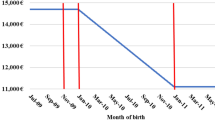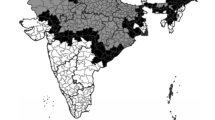Abstract
As part of welfare reform efforts in the 1990s, 23 states implemented family caps, provisions that deny or reduce cash assistance to welfare recipients who have additional births. We use birth and abortion records from 24 states to estimate effects of family caps on birth and abortion rates. We use age, marital status, and completed schooling to identify women at high risk for use of public assistance, and parity (number of previous live births) to identify those most directly affected by the family cap. In family cap states, birth rates fell more and abortion rates rose more among high-risk women with at least one previous live birth compared to similar childless women, consistent with an effect of the family cap. However, this parity-specific pattern of births and abortions also occurred in states that implemented welfare reform with no family cap. Thus, the effects of welfare reform may have differed between mothers and childless women, but there is little evidence of an independent effect of the family cap.
Similar content being viewed by others
References
Acs, G. (1996), The impact of welfare on young mother's subsequent childbearing decisions, Journal of Human Resources 31(4): 898–915.
Argys, L.M., Averett, S.L. & Rees, D.I. (2000), Welfare generosity, pregnancies and abortions among unmarried AFDC recipients, Journal of Population Economics 13: 569–594.
Bertrand, M., Duflo, E. & Mullainathan, S. (2002), How much should we trust differences-in-differences estimates? National Bureau of Economic Research, Inc. Working Paper 8841.
Blank, R. (2002), Evaluating welfare reform in the United States, Journal of Economic Literature XL(4): 1105–1166.
Blank, R.M., George, C.C. & London, R.A. (1996), State abortion rates: The impact of policies, providers, politics, demographics, and economic environment, Journal of Health Economics 15: 513–553.
Camasso, M.J., Harvey, C., Jagannathan, R. & Killingsworth, M. (1998a), A final report on the impact of New Jersey's family development program: Results from a pre-post analysis of AFDC case heads from 1990–1996, U.S. Department of Health and Human Services.
Camasso, M.J., Harvey, C., Jagannathan, R. & Killingsworth, M. (1998b), A final report on the impact of New Jersey's family development program. State of New Jersey Department of Human Services.
Camasso, M.J., Harvey, C., Killingsworth, M. & Jagannathan, R. (1999), New Jersey's family cap and family size decisions: Some findings from a five-year evaluation, unpublished manuscript, Rutgers University.
Camasso, M.J., Jagannathan, R., Harvey, C. & Killingsworth, M. (2003), The use of client surveys to gauge the threat of contamination in welfare reform experiments, Journal of Policy Analysis and Management 22(2): 207–223.
Center for Disease Control and Prevention (1999), Vital statistics of the United States: Natality, 1997. Technical Appendix.
Cook, P.J., Parnell, A., Moore, M. & Pagnini, D. (1999), The effect of short-term variation in abortion funding on pregnancy outcomes, Journal of Health Economics 18(2): 241–258.
Council of Economic Advisors (1997), Technical Report: Explaining the decline in welfare receipt, 1993–1996.
Dye, J.L. & Presser, H.B. (1999), The state bonus to reward a decrease in ‘illegitimacy': Flawed methods and questionable effects, Family Planning Perspectives 31(3): 142–147.
Dyer, W. & Fairlie, R. (2004), Do family caps reduce out-of-wedlock births? Evidence from Arkansas, Georgia, Indiana, New Jersey and Virginia, Population Research and Policy Review 23(5–6): 441–473 (this issue).
Fairlie, R.W. & London, R.A. (1997), The effect of incremental benefit levels on births to AFDC recipients, Journal of Policy Analysis and Management 16(4): 575–597.
Fein, D.J. (1999), Will welfare reform influence marriage and fertility? Evidence from the ABC demonstration, Abt Associates Inc.
Grogger, J. (2002), The behavioral effect of welfare time limits, American Economic Review 92(2): 385–389.
Grogger, J. (2003), Welfare transitions in the 1990s: The economy, welfare policy, and the EITC. National Bureau of Economic Research. Working Paper 9472.
Grogger, J. & Bronars, S.G. (2001), The effect of welfare payments on the marriage and fertility behavior of unwed mothers: Results from a twins experiment, Journal of Political Economy 109(3): 529–545.
Grogger, J., Karoly, L. & Klerman, A. (2002), Consequences of welfare reform: A research synthesis (DRU-2676-DHHS). Santa Monica, CA: RAND.
Hechman, J. & Smith, J. (1995), Assessing the case for social experiments, Journal of Economic Perspectives 9(2): 85–110.
Henshaw, S. (1998), Unintended pregnancy in the United States, Family Planning Perspectives 30(1): 24–29. 46.
Henshaw, S. (2000), Birth and abortion data. Available from http://www.welfareacademy. org/pubs/dataneeds/dataneeds-henshaw.pdf.
Henshaw, S. & Kost, K. (1996), Abortion patients in 1994–1995: Characteristics and contraceptive use, Family Planning Perspectives 28(4): 140–147.
Horvath-Rose, A.E. & Peters, E.H. (2001), Welfare waivers and nonmarital childbearing. For better and worse, in: pp.222-224, Welfare Reform and the Well-Being of Children and Families. New York: Russell Sage Foundation.
Jagannathan, R. & Camasso, M.J. (2003), Family cap and nonmarital fertility: The racial conditioning of policy effects, Journal of Marriage and the Family 65(1): 52–71.
Jagannathan, R., Camasso, M.J. & Killingsworth, M. (2004), New Jersey's family cap experiment: Do Fertility impacts differ by racial density? Journal of Labor Economics (in press).
Jones, R.K., Darroch, J.E. & Henshaw, S. (2002). Patterns in the socioeconomic characteristics of women obtaining abortions in 2000–2001, Perspectives on Sexual and Reproductive Health 34(5): 226–235.
Joyce, T, Kaestner, R. & Korenman, S. (2003), Welfare reform and non-marital fertility in the 1990s: Evidence from birth records, Advances in Economic Analysis & Policy 3(1): Article 6. Available from http://www.bepress.com/bejeap/advances/vol3/iss1/art6.
Kaushal, N. & Kaestner, R. (2001), From welfare to work: Has welfare reform worked? Journal of Policy Analysis and Management 20(4): 699–719.
Kearney, M., (2004), Is there an effect of incremental welfare benefits on fertility behavior? A look at the family cap, Journal of Human Resources (in press).
Klerman, J. (1998), Welfare reform and abortion, pp. 97–133, in: R. Moffitt (ed.), Welfare, the Family, and Reproductive Behavior: Research Perspectives. Washington, DC: National Academy Press.
Koonin L.M., Strauss, L.T., Chrisman, C., Montalbano, M., Bartlett, L.A. & Smith, J. (1999), Abortion surveillance – United States, 1996, in: CDC Surveillance Summaries (July 30), MMWR 48 (No. SS4).
Levine, P. (2002), The impact of social policy and economic activity throughout the fertility decision tree. National Bureau of Economic Research Working Paper 9021.
Levine, P. & Staiger, D. (2002), Abortion as insurance. National Bureau of Economic Research Working Paper 8813.
Loury, G. (2000), Preventing subsequent births to welfare recipients. Available from <http://www.welfareacademy.org/eval/loury.html>.
Lundberg, S. & Plotnick, R. (1995), Adolescent premarital childbearing: Do economic incentives matter? Journal of Labor Economics 13: 177–201.
Mach, T. (2001), Measuring the impact of family caps on childbearing decisions, unpublished manuscript, Department of Economics, State University of New York at Albany.
Matthews, S., Ribar, D. & Wilhelm, M. (1997), The effects of economic conditions and access to reproductive health services on state abortion rates and birthrates, Family Planning Perspectives 29(2): 52–60.
Mills, G., Kornfeld, R., Porcari, D. & Laliberty, D. (2001), Evaluation of the Arizona EMPOWER Welfare Reform Demonstration. Final report to the Arizona Department of Economic Security, Abt Associates Inc.
Moffitt, R.A. (1998), The effect of welfare on marriage and fertility, pp. 50–97, in: R. Moffitt (ed.), Welfare, the Family, and Reproductive Behavior: Research perspectives. Washington, DC: National Academy Press.
Moffitt, R.A. (2003a), The temporary assistance for needy families program, pp. 291–363, in, R.A. Moffitt (ed.), Means-tested transfer programs in the United States. Chicago: NBER/Chicago University Press.
Moffitt, R.A. (2003b), The role of randomized field trials in social science research: A perspective from evaluations of reforms of social welfare programs. DP 1264-03, IRP, University of Wisconsin. New York City Department of Health (1999), Summary of Vital Statistics 1998: The City of New York.
O'Neill, J.E. & Hill, M.A. (2001), Gaining ground? Measuring the impact of welfare reform on welfare and work. The Manhattan Institute, No. 17.
Rector, R. & Youssef, S. (1999), The determinants of welfare caseload decline. Center for Data Analysis Report #99-04. Washington, D.C: Heritage Foundation.
Rossi, P. (2000), New Jersey's family development program: An overview and critique of the Rutgers evaluation. Available from <http://www.welfareacademy.org/eval/ toc.cfm>.
Schoeni, R.F. & Blank, R.M. (2000), What has welfare reform accomplished? Impacts on welfare participation, employment, income, poverty and family structure. NBER Working Paper 7627.
Ventura, S.J. & Bachrach, C.A. (2000), Nonmarital childbearing in the United States, 1940–1999. National Vital Statistics Report, Centers for Disease Control and Prevention.
Author information
Authors and Affiliations
Rights and permissions
About this article
Cite this article
Joyce, T., Kaestner, R., Korenman, S. et al. Family cap provisions and changes in births and abortions. Population Research and Policy Review 23, 475–511 (2004). https://doi.org/10.1007/s11113-004-3461-7
Issue Date:
DOI: https://doi.org/10.1007/s11113-004-3461-7




